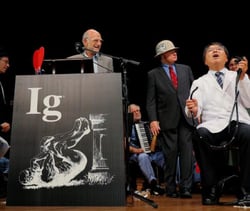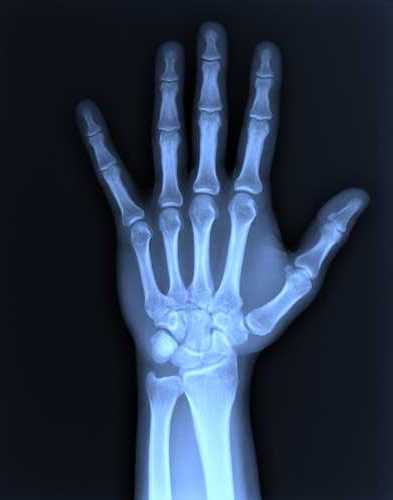Science is the process that allows humans to identify a problem and devise experiments to examine that problem and provide solutions. Not all scientific problems are created equal, but we can agree that all science, even those super mundane details that barely anyone ever thinks of, can be important to the whole of human knowledge. One of the great draws of science is that it is both rewarding and fun, and if ever there was a repository of high-brow humor, science is it. While we celebrate great discoveries every year with the Nobel Prizes, we also have an uproariously entertaining time with the annual Ig Nobel ceremony, a somewhat obscure but highly-anticipated event for the entire scientific community that shows the fun and human side of the "lauded" researchers. Let’s look at the Ig Nobel Prize, and some of the “greatest” Ig Nobel recognitions since the award’s inception in 1991.
What Are the Ig Nobels?
 Organized by the Annals of Improbable Research, every September at Harvard University, the Ig Nobel prizes honor “achievements that make people laugh, then think.” Ig Nobel is a portmanteau that riffs on the word "ignoble," meaning "unworthy," but the Ig Nobel is far from unworthy! While many of the awards are tongue-in-cheek, the discoveries that are recognized are in fact real, published in relatively niche journals at times, and after laughing at the absurdity, will raise awareness for science which is ultimately the goal of this ceremony. The humor and expertly-delivered innuendo are the hook, but the resulting discussion and the lasting impression of bizarre science spreads the message that communication and accessibility are key to successful scientific progress.
Organized by the Annals of Improbable Research, every September at Harvard University, the Ig Nobel prizes honor “achievements that make people laugh, then think.” Ig Nobel is a portmanteau that riffs on the word "ignoble," meaning "unworthy," but the Ig Nobel is far from unworthy! While many of the awards are tongue-in-cheek, the discoveries that are recognized are in fact real, published in relatively niche journals at times, and after laughing at the absurdity, will raise awareness for science which is ultimately the goal of this ceremony. The humor and expertly-delivered innuendo are the hook, but the resulting discussion and the lasting impression of bizarre science spreads the message that communication and accessibility are key to successful scientific progress.
The 2018 Ig Nobel ceremony. (Via Reuters, Brian Snyder)
The value of this ceremony is evident from the participation of prominent scientists, including actual Nobel laureates, who act as the presenters to the new Ig Nobel “winners.” In many ways, the Ig Nobels are the Golden Raspberry Awards of science as a counterpart to the Oscars show of the Nobels, although as far as I can tell (and I did some extensive searches), no scientist has ever slapped another while on stage (though I can’t say it has never happened in lab). Because these discoveries are real and published, no matter how ludicrous, they are forever part of the scientific literature and a resource for further experimentation and exploration. The ceremony is dotted by the audience throwing paper airplanes in celebration along with super fast, 60-second speeches summarizing the winning discoveries.
The Most Memorable Ig Nobel “Innovations”
I'd love to attend an Ig Nobel ceremony someday and throw a paper airplane. Distilling decades of Ig Nobel-worthy research into a top ten list would seem mind-boggling, but let’s try anyway! In addition to the normal categories shared with the Nobel Prizes, the Ig Nobel Prize also celebrates “achievements” in diverse fields such as anthropology, art, nutrition, and various medical disciplines including reproductive medicine.
These are ten Ig Nobel "winning" discoveries, in no particular order, that I thought were funny but also potentially quite useful to humanity, once you get past the silliness. It is a great reminder that science is awesome and fun, the way it should be!
The importance of good STEM education
 As a former teacher and a lifelong advocate of science literacy, this one really spoke to me. The inaugural Ig Nobel ceremony in 1991 used its Education award to “celebrate” the sitting Vice President of the United States, Dan Quayle, for “demonstrating, better than anyone else, the need for science education.” Vice President Quayle, for those of you not familiar, had an infamous reputation for often appearing to be confused.
As a former teacher and a lifelong advocate of science literacy, this one really spoke to me. The inaugural Ig Nobel ceremony in 1991 used its Education award to “celebrate” the sitting Vice President of the United States, Dan Quayle, for “demonstrating, better than anyone else, the need for science education.” Vice President Quayle, for those of you not familiar, had an infamous reputation for often appearing to be confused.
Highlighting contradictory findings
The beauty of science is that different research groups can frequently come to different, often opposing, conclusions about the same phenomenon. During the 2021 Ig Nobel ceremony, the Physics Prize went to a multi-national group that conducted experiments to learn why pedestrians do not constantly collide with other pedestrians. The Kinetics Prize went to another multi-national group that conducted more experiments to learn why pedestrians do sometimes collide with other pedestrians. This does remind me of when I learned statistics from my friend and fellow lab mate, in which we can consider that the 95% confidence interval holds all the pedestrians who don’t collide, while the outliers are the ones that do bump into each other. I think this is also useful for understanding that scientists can continue to test hypotheses until they have a better model for a phenomenon, even one as wacky as pedestrian collisions.
The Value of Authentic Ingredients
 Every major region claims it has the best pizza, but other than Chicago deep dish, the most authentic pizza is from where the food originated in Italy. To honor this doctrine and its potential therapeutic usage, Silvano Gallus was awarded the 2019 Ig Nobel in Medicine for publications detailing the protective qualities of Italian pizza, but only if it was made and eaten in Italy. Gallus gathered evidence for pizza benefits against various cancers and heart disease, which at first seems odd because all the free pizza I ate at grad school seminars was greasy and gross, but then again, that pizza was definitely not made (nor eaten) in Italy.
Every major region claims it has the best pizza, but other than Chicago deep dish, the most authentic pizza is from where the food originated in Italy. To honor this doctrine and its potential therapeutic usage, Silvano Gallus was awarded the 2019 Ig Nobel in Medicine for publications detailing the protective qualities of Italian pizza, but only if it was made and eaten in Italy. Gallus gathered evidence for pizza benefits against various cancers and heart disease, which at first seems odd because all the free pizza I ate at grad school seminars was greasy and gross, but then again, that pizza was definitely not made (nor eaten) in Italy.
The best pizza outside of Italy is delivered in this box.
The Inevitability of Disaster
All scientists know the usually devastatingly high failure rate as they pursue life’s great answers. In tribute to this immutable principle of experimental despair, the 2003 Ig Nobel Prize in Engineering was awarded to the purveyors of Murphy’s Law, which can be summarized as “if anything can go wrong, it will.” Unfortunately, two of the three awardees had passed, but unlike the Nobel Prize, the Ig Nobel can be awarded posthumously, and since we can all relate to Murphy’s Law, this is a well-deserved honor.
The Sweet Smell of Success
In my youth, one of the trendy gimmicks was “scratch and sniff” stickers, where scent particles were affixed to the surface of the sticker. I assume that these particles are volatilized when a scratch broke the surface on a molecular level. Similar devices were included in various magazines that would adorn the waiting room of the dentist’s office, but for perfumes and colognes. In 1993, the Ig Nobel Prize in Chemistry was awarded to James and Gaines Campbell (unsure of relation) for inventing these scent strips, which are still in use to this day! (I know because I have to go to Bath and Body Works with the wife quite a bit.)
Ig Nobel Can Lead to Greater Things
Sir Andre Geim was awarded the 2000 Ig Nobel Prize in Physics for showing that he could made a frog float in the air using its intrinsic magnetism (and oh my, there’s a video!). Geim suggested that something like his magnetic contraption could be employed to levitate a human being as well, which I think they riffed on in the last Daniel Craig James Bond movie. Perhaps you might know Geim better as the 2010 Physics Nobel Prize winner for his work on the unique carbon compound graphene, which has given rise to new experimental possibilities due to its strength and conductive properties. Geim’s achievement makes him the science community’s equivalent of Sandra Bullock, who famously “won” a Razzie the day before she won her acting Oscar for The Blind Side.
The Gates of Hell
 In 2001, the Ig Nobel for Astrophysics was awarded to a couple of evangelists for discovering that black holes are basically the location of Hell. Some may consider Hell to be at the Earth’s core or somewhere in Michigan, but it seems this Ig Nobel discovery was widely accepted. Years later, when images of black holes were finally captured, the astrophysicists paid homage by referring to “The gates of Hell, the end of space and time.” Knowing that black holes are so supermassive and have such gravity that not even light can escape, it was suggested that “Perhaps it is the closest thing there is to Hell: it is an abyss, a moment of oblivion.”
In 2001, the Ig Nobel for Astrophysics was awarded to a couple of evangelists for discovering that black holes are basically the location of Hell. Some may consider Hell to be at the Earth’s core or somewhere in Michigan, but it seems this Ig Nobel discovery was widely accepted. Years later, when images of black holes were finally captured, the astrophysicists paid homage by referring to “The gates of Hell, the end of space and time.” Knowing that black holes are so supermassive and have such gravity that not even light can escape, it was suggested that “Perhaps it is the closest thing there is to Hell: it is an abyss, a moment of oblivion.”
What’s In a Name?
Even veterinary medicine deserves recognition because animals provide so much benefit to humanity, from livestock and labor to their use in animal models of physiology and disease. The 2009 Veterinary Medicine Prize was awarded to Catherine Douglas and Peter Rowlinson, for showing that cows with names can produce more milk than nameless cows. I guess there is something to good vibes in farming, and perhaps cows who have better connections to their humans will manifest those positive energies into lactation!
Money Matters
I know Enron mostly because they had the initial naming rights to the Houston Astros ballpark, which is probably more famous for their architectural controversies in the field of play than anything else. Enron is infamous for irregular accounting procedures that led to their bankruptcy and dissolution in the early 2000s. In 2002, along with many other companies that may have gone defunct due to the bursting of the dot-com bubble and obsolescence of goods and services, Enron was awarded the 2002 Ig Nobel in Economics for their use of imaginary numbers in business. I don’t think they actually used the square root of a negative number, but arguably money is an imaginary concept in some respects given the rise and likely fall of cryptocurrencies and non-fungible tokens.
Feline Troubles
 Cats are low maintenance but lovely additions to one’s family (mine is to the left), although they have poor habits of destroying furniture and occasionally limbs depending on their moods. The Ig Nobels have recognized “cat science” many times, notably in 2014 when the Public Health Prize was awarded to a multi-national group for “investigating whether it is mentally hazardous for a human being to own a cat” (probably) and in 2021 when the Biology Prize was awarded to a Swedish group for analyzing cat “speech patterns” in their communication with humans. One can imagine life with a cat (including mine, seen to the left) being much more bearable (not that they’re totally evil!) if one could communicate with the feline monstrosity more effectively!
Cats are low maintenance but lovely additions to one’s family (mine is to the left), although they have poor habits of destroying furniture and occasionally limbs depending on their moods. The Ig Nobels have recognized “cat science” many times, notably in 2014 when the Public Health Prize was awarded to a multi-national group for “investigating whether it is mentally hazardous for a human being to own a cat” (probably) and in 2021 when the Biology Prize was awarded to a Swedish group for analyzing cat “speech patterns” in their communication with humans. One can imagine life with a cat (including mine, seen to the left) being much more bearable (not that they’re totally evil!) if one could communicate with the feline monstrosity more effectively!



